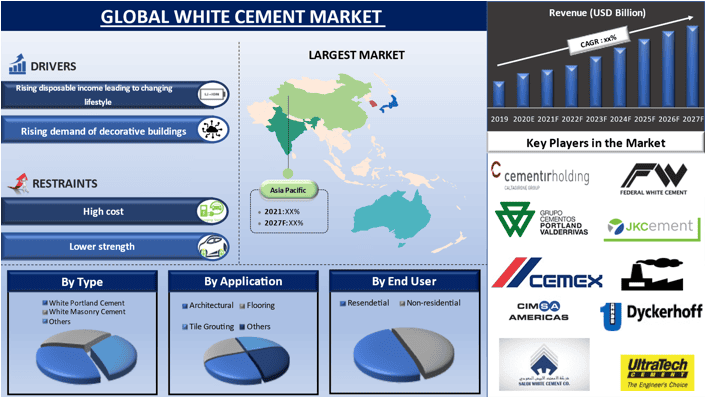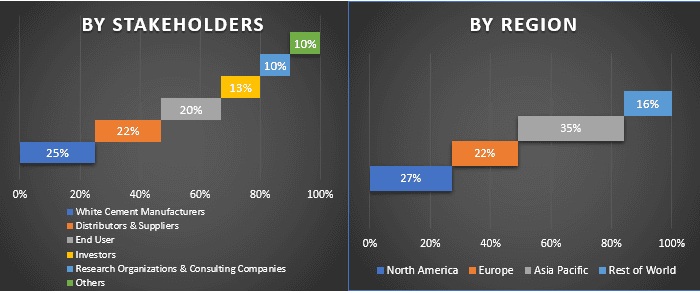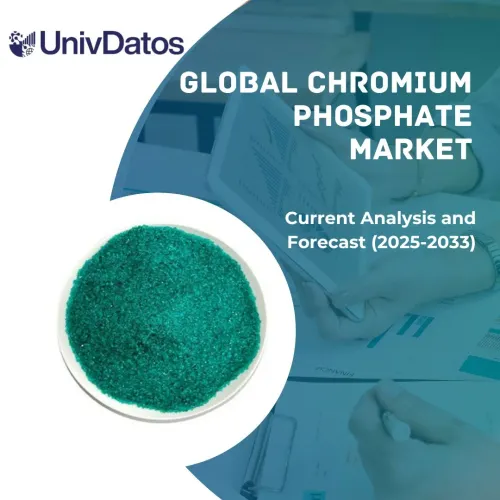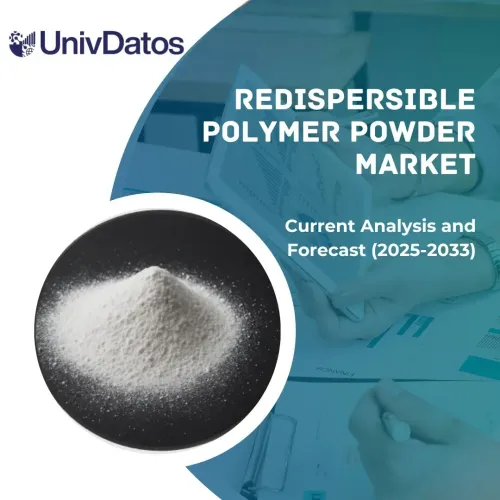- Home
- About Us
- Industry
- Services
- Reading
- Contact Us
White Cement Market: Current Analysis and Forecast (2021-2027)
Emphasis on Type (White Portland Cement, White Masonry Cement and Others); Applications (Architectural, Flooring, Tile Grouting, Others); End User (Residential and Non-residential); and Region/Country

White Cement Market was estimated to be around 5 billion in 2020 and is anticipated to display a CAGR of around 4% over the forecast period (2021-2027). Less strength and higher cost of white cement in comparison of grey cement is restraining the demand. In developing nations like India, Brazil, and Argentina population is migrating towards urban areas which is driving the growth of residential construction industry. Moreover, rising disposable income and changing lifestyle is increasing the need for decorative houses. This is leading to increase in demand of construction materials like white cement which is increasingly used for finishing the interior and exterior walls is fueling the growth of white cement market. However, major key players are adopting different strategies such as acquisition, business expansion, and collaboration in order to survive in highly competitive market. In 2020, UltraTech Cement announced a USD 748.8 million expansion plan that will add 12.8 million tons of cement production to its annual capacity.
Cementir Holding SPA, Cementos Portland Valderrivas S.A., Cemex S.A.B. DE C.V., Cimsa Cement Industry and Trade Inc., Dyckerhoff GmbH, Federal White Cement, JK Cement Ltd., Neyriz White Cement Company, Saudi White Cement Co., Ultratech Cement Ltd. are some of the prominent players operating in the white cement market. Several M&As along with partnerships have been undertaken by these players.
Insights Presented in the Report
“Amongst Type, White Portland Cement segment holds the major share.”
Based on the type, white cement market is divided into white portland cement, white masonry cement, and others. Currently, white portland cement holds a lucrative market share as it has more compressive strength and more durable than white masonry cement.
“Amongst Applications, Flooring held lucrative market share in 2020.”
Based on application, the market is segmented into architectural, flooring, tile grouting, and others. Among all, flooring category held a lucrative market share as polished concrete floors deliver clean, beautiful, and economical floor designs that are resilient and long-lasting. A large supermarket chains and grocery stores likes the advantages offered by white concrete floor surfaces and has committed itself to placing light reflective floors in these new facilities. The white concrete floor has a consistent color throughout its entire depth. For instance, total retail units of Walmart Inc. rose to nearly 11,500 in 2020 from 11,200 in 2018. Increasing supermarket chains would lead to rise in construction which would further lead to increased demand of white cement.
“Amongst End User, Residential Sector hold a prominent market share.”
Based on end user, market is sub-segmented into residential and non-residential sector. Residential sector holds considerable market share which is mainly owing to higher purchasing power of end users. Moreover, non-residential sector is expected to grow considerably due to increasing globalization.
“Asia Pacific represents as the largest market in the White Cement Market.”
For better understanding of the market penetration of white cement, the report provides a detailed analysis of major regions including North America, Europe, Asia Pacific, and the rest of the world. The increasing urbanization makes way for increasing construction activities providing growth opportunity for the overall market. It increases the need of white cement products including facades tiles, trim boards especially in the countries such as India, Japan, and China. Further, growing infrastructure developments are fueling construction activities such as construction of roads, flyovers, railway stations and others. These factors are fostering the growth of the construction sector, and thereby, the consumption of white cement.
However, major cement companies have identified immediate business risks on account of Corona Virus. For example, net profit of Ultratech Cement reduced to USD ~714 Mn in 2021 as compared to USD ~772 Mn in 2020.
Reasons to buy this report:
- The study includes market sizing and forecasting analysis validated by authenticated key industry experts
- The report presents a quick review of overall industry performance at one glance
- The report covers an in-depth analysis of prominent industry peers with a primary focus on key business financials, product portfolio, expansion strategies, and recent developments
- Detailed examination of drivers, restraints, key trends, and opportunities prevailing in the industry
- The study comprehensively covers the market across different segments
- Deep dive country-level analysis of the industry
Customization Options:
White Cement Market can further be customized as per the requirement or any other market segment. Besides this, UMI understands that you may have your own business needs, hence feel free to connect with us to get a report that completely suits your requirements.
Table of Content
Analyzing the historical market, estimation of the current market, and forecasting the future of the global white cement adoption were the three major steps undertaken to create and analyze the adoption of white cement across various segments in North America, Europe, Asia Pacific, and Rest of the world. Exhaustive secondary research was conducted to collect the historical market numbers and estimate the current market size. Secondly, to validate these insights, numerous findings and assumptions were taken into consideration. Moreover, exhaustive primary interviews were also conducted, with industry experts across the value chain of the white cement sector. Post assumption and validation of market numbers through primary interviews, we employed a top-down/bottom-up approach to forecast the complete market size. Thereafter, market breakdown and data triangulation methods were adopted to estimate and analyze the market size of segments and sub-segments the industry pertains to. Detailed methodology is explained below:
Analysis of Historical Market Size
Step 1: In-Depth Study of Secondary Sources:
Detail secondary study was conducted to obtain the historical market size of the white cement through company internal sources such as annual report & financial statements, performance presentations, press releases, etc., and external sources including journals, news & articles, government publications, competitor publications, sector reports, third-party database, and other credible publications.
Step 2: Market Segmentation:
After obtaining the historical market size of the white cement market, we conducted a detailed secondary analysis to gather historical market insights and share for different segments & sub-segments for major regions. Major segments included in the report as type, application, and end user. Further regional & country-level analyses were conducted to evaluate the overall adoption of the white cement in the global context.
Step 3: Factor Analysis:
After acquiring the historical market size of different segments and sub-segments, we conducted a detailed factor analysis to estimate the current market size of white cement. Further, we conducted factor analysis using dependent and independent variables such as rising construction activities and high purchasing power of population. A thorough analysis was conducted for demand and supply-side scenario considering top partnerships, merger and acquisition, business expansion, and product launches in the white cement industry.
Current Market Size Estimate & Forecast
Current Market Sizing: Based on actionable insights from the above 3 steps, we arrived at the current market size, key players in the global white cement market, and market shares of the segments. All the required percentage split, and market breakdowns were determined using the above-mentioned secondary approach and were verified through primary interviews.
Estimation & Forecasting: For market estimation and forecast, weights were assigned to different factors including drivers & trends, restraints, and opportunities available for the stakeholders. After analyzing these factors, relevant forecasting techniques i.e., bottom-up approach was applied to arrive at the market forecast to 2027 for different segments and subsegments across the major regions globally. The research methodology adopted to estimate the market size encompasses:
- The industry’s market size, in terms of value (US$) and the adoption rate of white cement across the major markets
- All percentage shares, splits, and breakdowns of market segments and sub-segments
- Key players in the white cement market in terms of services offered. Also, the growth strategies adopted by these players to compete in the fast-growing market.
Market Size and Share Validation
Primary Research: In-depth interviews were conducted with the Key Opinion Leaders (KOLs) including Top Level Executives (CXO/VPs, Sales Head, Marketing Head, Operational Head, and Regional Head, Country Head, etc.) across major countries. Primary research findings were then summarized, and statistical analysis was performed to prove the stated hypothesis. Inputs from primary research were consolidated with secondary findings, hence turning information into actionable insights.
Split of Primary Participants in Different Regions

Market Engineering
Data triangulation technique was employed to complete the overall market estimation and to arrive at precise statistical numbers of each segment and sub-segment of the global white cement market. Data was split into several segments & sub-segments post studying various parameters and trends in the areas of type, application, and end user.
The main objective of the white cement market study
The current & future market trends of white cement were pinpointed in the study. Investors can gain strategic insights to base their discretion for investments from the qualitative and quantitative analysis performed in the study. Current and future market trends determine the overall attractiveness of the market at a global & country level, providing a platform for the industrial participant to exploit the untapped market to benefit as a first-mover advantage. Other quantitative goals of the studies include:
- Analyze the current and forecast market size of white cement in terms of value (US$). Also, analyze the current and forecast market size of different segments and sub-segments
- Segments in the study include areas of type, application, and end user. Defined analysis of the regulatory framework for the white cement industry
- Analyze the value chain involved with the presence of various intermediaries, along with analyzing customer and competitor behaviors of the industry
- Analyze the current and forecast market size of the white cement for the major regions & countries
- Major regions studied in the report include North America, Europe, Asia Pacific, and Rest of World
- Company profiles of the white cement market players and the growth strategies adopted by them to sustain in the fast-growing market
- Deep dive regional & country level analysis of the industry
Related Reports
Customers who bought this item also bought










